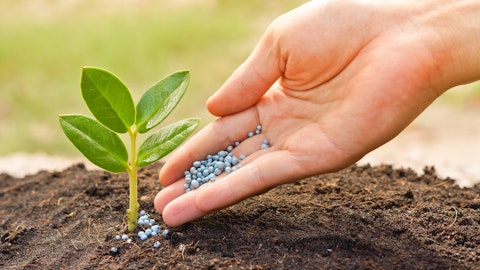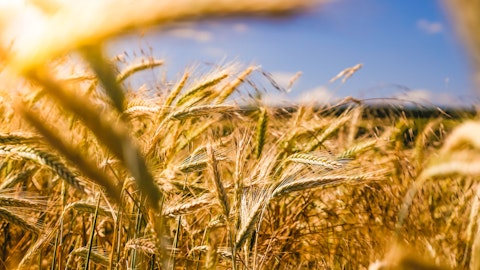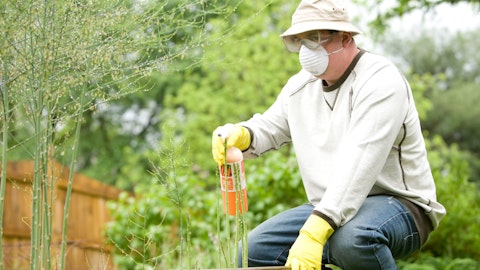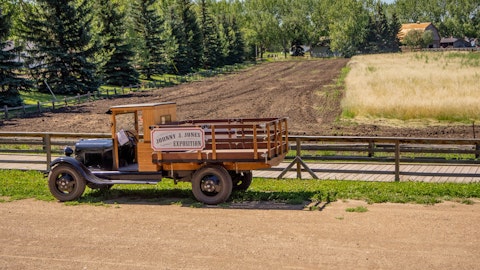Bioceres Crop Solutions Corp. (NASDAQ:BIOX) Q2 2023 Earnings Call Transcript February 9, 2023
Operator: Hello and welcome Bioceres Crop Solutions Fiscal Second Quarter 2023 Financial Results Conference Call. My name is Drew, and I’ll be your operator today. I would now like to turn the call over to Paula Savanti, Head of Investor Relations. Please go ahead.
Paula Savanti: Thank you. Good morning and welcome to everybody. Thank you for joining. Presenting today during the call will be Federico Trucco, our Chief Executive Officer; and Enrique Lopez Lecube, our Chief Financial Officer. Both will be available for the Q&A session. Before we proceed, I would like to make the following Safe Harbor statements. Today’s call will contain forward-looking statements and I refer you to the forward-looking statements section of today’s earnings release and presentation as well as the recent filings with the SEC. We assume no obligation to update or revise any forward-looking statements to reflect new or changed circumstances. This conference call is being webcast and the webcast link is available at the Bioceres Crop Solutions Investor Relations website. At this time, I will turn the call over to our CEO, Federico Trucco. Thank you.
Federico Trucco: Thank you, Paula and good morning everyone and welcome to our second quarter earnings call. Please turn to slide three from the deck for a quick overview of these period’s business and financial highlights. As we have anticipated during our prior earnings call, our growth momentum has been momentarily interrupted by unusually severe drought conditions in Argentina that extended throughout the entire planting window for summer crops. Although we are flat when compared to last year’s revenue for the quarter, we are down by 7% year-over-year for the period on a pro forma basis after including Pro Farm’s operations. This circumstantial decline interrupts a run of seven consecutive quarters of topline growth and profitability expansion, which we expect to resume in the second half of the fiscal year as weather conditions have turned more favorable in our key commercial regions.
On a less circumstantial and more permanent front, the severe drought conditions in Argentina have allowed us to put HB4 technology to the desk like never before. And the performance of HB4 wheat has been outstanding in all fronts. In environments yielding less than two tonnes per hectare, HB4 wheat was — has outperformed commercial materials by an average yield improvement of 43%. HB4 soy contract despite unusually difficult planting conditions in Argentina, half of the current seed multiplication area was planted with new generation varieties, which will help us quickly rotate the existing portfolio and improve performance compared to the earlier materials. An important milestone on the HB4 soy front was the initiation of the multiplication program with farmers in Brazil, which we expect to give us enough seed for an initial 10,000 hectares in the upcoming season.
We have closed our previously announced acquisition of wheat breeding assets in Australia, where we expect to expand on the HB4 opportunity after Latin America. We’ll discuss all these highlights in greater detail throughout the presentation, but let us first better magnify the severity of the drought experienced in Argentina and for that please turn to the next slide. The past drought in Argentina was of historical proportions due to two main factors; its length, extending throughout the winter and pass the entire summer crop planting window; and its reach affecting a very large part of the agriculturally productive area of the country. Wheat output was slashed by 50% compared to the prior year, and the planting of summer crops displaced by 20 to 30% outside of the optimal planting window with an irreversible decline in total crop area and unexpected production decline well above 20% compared to the year before.
Enrique will now describe, sort of, a financial implications of this drought, and then I will provide detailed information on HB4 performance, which obviously has experienced a unique year in terms of the severity of the weather event. Enrique?
Enrique Lopez Lecube: Thank you, Federico, and good morning to everyone on the call today. Federico indicated I’d like to dive further into our financial results and provide some insight on our expectations for the remainder of our 2023 fiscal year. As we have often mentioned in previous calls, geographical portfolio diversification are cornerstones to our long-term strategy, and once that drove decisions like investing into a new facility in Brazil, or even the merger with Pro Farm, both initiatives that we expect to deliver substantial revenue growth. Yes, Argentina remains an important and profitable end market to us. And, of course, the situation Federico just described presented a challenge for sales and profit of our baseline business in Argentina, as much as it offered a great opportunity to highlight the strong needs of technologies like HB4 in the context of challenging weather conditions.
Before diving into discussing our financial performance, we must note here that all numbers referenced in this presentation include Pro Farm figures, and all year-over-year comparisons are made against pro forma numbers, which include Pro Farm historical figures this for easier comparison. As you can see on slide 4, the first half of our fiscal year started strong with a 26% increase in revenues. This performance is a contrast of two quarters. You will recall that we reported a 71% increase in revenues in the first quarter, which was driven by an outstanding performance of our crop protection and crop nutrition segments. In part as a result of our commercial teams looking in early sales in anticipation of what already looked like a dry season.
While we anticipated drought conditions, the severity was beyond anyone’s expectations, particularly in the most productive growing regions of Argentina. Our 7% decline in second quarter revenues reflected the slowdown in volumes as farmers minimize their investments due to a lack of rains in the planting season. An estimated $20 million to $25 million of potential sales were lost because of the weather during the quarter. Approximately, half of this total represents a permanent loss from products that would have been used in summer crops planting activities, such as seed treatment packs and fertilizers. Also, as I just pointed out, a portion of second quarter plant sales were realized in the first quarter of our fiscal year 2023 in anticipation of challenging weather conditions.
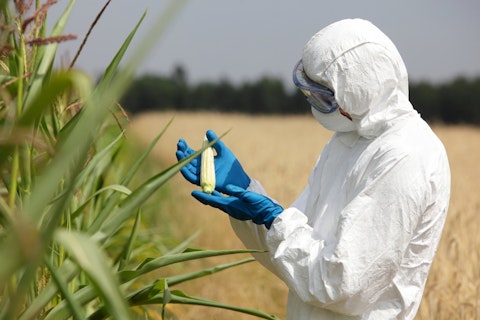
Marcin Balcerzak/Shutterstock.com
On slide 5, we can see the segments most affected in the quarter and also the value of our diversification strategy that helped mitigate the revenue loss. Despite weather conditions during soybean planting being amongst the worst of the last two decades in Argentina, we recorded our first HB4 soybean revenues, and this supported the 7% growth in Seed & Integrated Products segment. HB4 sales were partially offset by the decrease in seed treatment packs. Importantly, during the second quarter, we launched the HB4 soy program with growers in Brazil, which we expect to ramp up significantly in the coming two seasons, helping us further diversify weather risk through geographic expansion. Crop Protection revenues declined by 5%, a thrive weather led to less pest pressure and decreased demand for fungicides, insecticides and adjuvants in Argentina.
This product lines continued to deliver growth in other regions of Latin America. But the main contribution to partially offsetting the drop in Argentina was done by Pro Farm product sales in the US through increased adoption of our biological seed production products. Again, in terms of geographic diversification, it is comforting to see how all of this is playing out. Crop Nutrition saw the largest sales decline at 16%. mostly driven by lower microbeaded fertilizers sales in Argentina. Our farmers were reluctant to invest heavily on fertilizing crops that were planted beyond the optimal planting window and thus, less likely subject to lower yields. I would like to point out that improved rainfall during the month of January, we stored some soil moisture with generates expectations of an end to the drought.
Normalization of rainfall would foster the use of crop protection products. But more importantly could trigger a meaningful increase in winter crops acreage if farmers intend to recover profitability loss from soybeans and corn through newly planted wheat and barley. Both these dynamics, the resuming crop protection sales and higher winter crops acreage would allow us to recover a portion of sales lost to drought in Argentina, and provide a favorable scenario for the rollout of HB4 wheat, putting us on track for our annual sales plans. Please turn to slide 6. For the first half of the year, we delivered a 5% increase in gross profit, which was driven by first quarter performance mostly. In the second quarter though, gross profit was down 28% due to a combination of price and product mix effects.
Product mix played a role this quarter as sales contribution of higher margin products such as adjuvants and seed treatment packs sell relative to others. Both products are highly seasonal in the second quarter and were impacted by dry weather. In addition, there was some margin contraction across the portfolio in Argentina, particularly in the case of fertilizers, as the pricing strategy was adjusted to accommodate for the drought conditions, and mostly aimed at maintaining market share through customer proximity. For the full year, as rainfall in Argentina normalizes, we do expect our margins for sales in the country to trend back to normal and get us back on track with our annual goals. Please now refer to slide 7. Adjusted EBITDA for the second quarter was affected by the negative impact on sales and margins in Argentina.
The corresponding decrease in gross profit was partially offset by lower operating expenses when excluding non-cash considerations and one-timers such as D&A transaction expenses and share-based incentives. This reduction was driven by good performance in the execution of cost synergies derived from the merger with Pro Farm. As we grow Pro Farm revenues and complete the integration process, we continue to believe we are on path for this acquisition to be adjusted EBITDA neutral for the full year. We saw good progress toward this goal in the quarter. Importantly, despite a tough second quarter adjusted EBITDA for the first half of the fiscal year 2023 reached almost $35 million, which represents a 13% improvement compared with the first half of the previous fiscal year on a pro forma basis.
Finally, let’s please look at the summary of our financial position shown on slide 8. Our higher debt position and the corresponding higher interest expenses are mainly explained by the execution of the agreements in connection to the merger with Pro Farm. The increase in short-term debt is explained in full by high working capital position from incorporating Pro Farm as well as progress in launching HB4. We remain at a very healthy run rate of interest expenses with an annualized average cost of debt of approximately 7%. Our cash position increased with a $50 million upfront payment from the Syngenta agreement and stood at roughly $87 million, leading to a net financial debt of $170 million on December 31st, 2022. Our net debt-to-adjusted EBITDA ratio was 3.13 times.
And although our target is to keep our leverage ratio below returns, we are comfortable as the current metric is fully explained by a temporary drop in this quarter’s EBITDA. More importantly, we have a strong cash position and our working capital is well above our short-term debt obligations. After quarter close, we completed a $26.6 million public offering of corporate bonds in the Argentine market to support our local business in the country. These bonds mature in February 2025 and February 2026, and pay annual rates of 1.5% and 3.9% correspondingly. All the proceeds will be used to pay down short-term debt, thus improving the composition of short and long-term financial debt. Let me wrap up by saying that although this quarter breaks a two year streak of uninterrupted growth due to an exogenous weather shock, we are confident in the underlying fundamentals of our business.
While weather may temporarily affect our quarterly results, from time-to-time, our long-term growth trajectory remains robust. With that, I will hand the floor over to Federico. Federico?
Federico Trucco: Thanks, Enrique. And please turn to the next slide so that we dive into the HB4 wheat results. When we talk about the HB4 targeted region as an area or as areas where yields are expected to be below the two tons per hectare mark, we may think of these as a limited opportunity in normal years, when average yields are often above the three tons per hectare level. Now, in a crop year, like the one we just experienced, over 30% or close to 2 million hectares nationwide, were below this threshold. So to be able to improve yields consistently in these fields by more than 40% as shown in multiple seasons, it’s quite outstanding. We are not longer talking about field trials, or limited number of fields. These are results from hundreds of growers, thousands of hectors, and multiple seasons, indeed, very compelling.
But let’s go slightly more scientific in our analysis and look at the isolated effect of the HB4 gene. As we turn to the next slide. What we did here in 20 different locations, or 34 locations, if we look at the past three years, was to ask farmers to compare twins, or what we call near isogenic lines that are varieties otherwise genetically identical except for the presence or absence of the HB4 gene. This is important because as you may well know by now, final performance of an HB4 varieties often compounded by its genetic background. So we talk about first generation materials, second generation materials, or even third generation materials, like we do in soil. Now, when we neutralize that background noise, what we see is that HB4 converted lines win in all environments, not just those with yields below two tonnes per hectare.
HB4 is the true yielding with wind rates above 80%, ratifying the broad hectare opportunities resulting from this technology. So, as we improve background genetics and reduce the yield gap of the first generation materials in environment with yields above four tonnes per hectare, we can expand the HB4 opportunity to the entire wheat production area and this is what we are showing in the next slide with that close to 15% yield improvement observed in the highest yielding environments during the last season when compared when comparing the data from last year, from first generation materials to what we observed with second generation materials in the current year. The good news is that, we should be able to cover up to one-third of next seasonal HB4 plantings with second generation materials, allowing us to replace first generation varieties, almost fully by fiscal year 2024 when we expect HB4 we do deliver between $15 million to $20 million in enterable EBITDA.
Now, this technology is too important for it to be limited to Latin America and our ambition is to bring HB4 Wheat to farmers everywhere in the world where wheat relevant and droughts are prevalent. And the next stop in this route for us is Australia. So in line with these, we have closed the previously announced deal with S&W Genetics, acquiring for our subsidiary Trigall Genetics 80% ownership of their wheat breeding program. This is shown in the next slide. Australia will not become an immediate opportunity for HB4 Wheat since we have to still do regulatory working country. We have been clear from a food and feed perspective, but not yet from a production viewpoint. So that is expected to be done in the next two years, while we consolidate the breeding efforts locally and start developing the adapted HB4 lines.
We believe that HB4 in Australia will become meaningful in about five years. And that is beyond sort of our peak penetration in Latin America. So, a good way to follow up on what we are currently doing in Argentina, Brazil, and the rest of the region. Finally, to close the earnings call, I’d like to provide a brief update on HB4 soy. HB4 soy see multiplication hectares were kept steady, despite very challenging planting conditions. As we commented earlier in the presentation, importantly, half of the multiplication area was planted with the newest varieties, nine new third generation materials that will allow us to quickly rotate the portfolio and improve performance for these crops. And inventory projections are on track to meet what we expect to fiscal ’24 and meet the guidance that we provided for fiscal ’25.
As Enrique indicated, we are delighted to see HB4 advancing in Brazil with initial multiplications being done with farmers from using two varieties derived from the TMG program and hope hopefully, target about 10,000 hectares in the upcoming season. So with these, I think we can now open up the floor for Q&A. So, operator.
See also 25 Largest Illinois Companies and 25 Countries that Have the Most Debt Per Capita.
Q&A Session
Follow Bioceres Crop Solutions Corp. (NYSE:BIOX)
Follow Bioceres Crop Solutions Corp. (NYSE:BIOX)
Operator: Thank you. We will now start today’s Q&A session. Our first question today comes from Ben Klieve from Lake Street Capital Markets. Your line is now open.
Ben Klieve: All right. Thanks for taking my questions and congratulations on really solid first half despite the tough backdrop that you outlined. First question Enrique is for you. You note $20 million to $25 million revenue headwinds in the period due to weather. And I confused myself a little bit kind of breaking this down. So I want to clarify this, if possible. You suggested that half of it was a permanent loss. So, was the other half pulled forward into Q1, or was the other half you think can be pushed right into Q3?
Enrique Lopez Lecube: Hi, Ben. Thanks for the question and good to have you on the call. So, that is a good question. So, the half that was permanently lost was a mainly around fertilizers and seed treatment packs, both things that are heavily used on the planting window. And obviously, those are tasks that don’t go back. So that’s the part that we believe it’s going to not come back. The remaining half, I would say then that has to do mostly with products that were pushed further down the road. So for example, in the case of adjuvants, if there is more rain, than obviously that would explain more spraying and more spraying resumes, sort of like our sales of adjuvants in the country. So there’s a big part of that even with fertilizers.
And that’s why I highlighted the wheat acreage. We might recover some of our annual estimated sales of fertilizers in wheat. So what we lost in soil might be recovered in wheat. And there’s obviously a part of that that got pulled into the first quarter, but mostly is what was lost to planting activities. That explains that half that was lost and the remaining is something that we do believe, that can be fully recovered through more adjuvant sales, maybe some insecticide sales, and most importantly, fertilizers for wheat planting in the winter crops planting season in late May, June.
Ben Klieve: Okay, very helpful. Thank you. On the HB4 Soy, a lot of positive news here. Did you provide the revenue contribution for HB4 Soy in the quarter? If so, I missed it. And then do you expect 100% of HB4 Soy revenues this fiscal year to be in the second quarter, or do you think any of that is going to get pushed into Q3 for some reason?
Enrique Lopez Lecube: No, no, obviously, what’s happened in HB4 Soy, already happened. So that’s in the second quarter. All of that happens in the second quarter. The contribution was a $2.2 million. And this is something that I believe that it’s also worth putting in context of the drought. I mean, obviously, farmers decide to spend less on technology as they see sort of like drought complications. And even though HB4 is a drought trade, is not something that allows to surpass planting difficulty. So if you don’t have enough soil moisture, obviously, you’re not going to be able to plant and it’s not something that can be solved through HB4. So I think that we were expecting probably to see a little bit higher sales. And this situation with drought was a little bit complicated on that. I don’t know, Federico, if you want to add something on that front?
Federico Trucco: No. The reality is that we were targeting twice as much to be fully honest, and we lost many fields that were not planted. That probably doesn’t explain a 100% of the situation, what we priorities, then was the multiplication of the new varieties. So that got all planted. So all the inventory we had, or third generation materials, which are very relevant from an inventory ramp up viewpoint, got done. The incremental revenues that come from second generation materials, or even that may be a first generation material that we were targeting to meet that revenue threshold is what we compromised, if you will, because of a situation described by Enrique. So from from a strategic viewpoint or ability to rotate and have the inventory in place for the meaningful years, I think we’re in good shape, even though we’re below where we expected to be coming into the quarter.
Ben Klieve: Got it. Got it. That makes sense and yes, very sensible. Okay, last one for me. And then I’ll get back and queue. You noted that the cap contributions from the Syngenta agreement, you know now that operationally this is, you know, six months six weeks old, something like that. Do you have any operational updates on how this agreement is proceeding here in the early days, or is it still too early to really make any comments there?
Federico Trucco: No, I think we’re making very good progress in terms of manning the agreement, having the people in place that can operate the sales that are required, so we are helping Syngenta on that front. And that has been fully accomplished, for instance, in Brazil, which is a very important geography for the objectives of the agreement. Remember that we are targeting on average $23 million of profits coming from this agreement on an annual basis, on top of the prepayment that we got. That is reported here. So I think that is moving as good as it can go. We believe that this is in a way the sort of the floor of the opportunity because we will see tremendous momentum for biological seed treatments globally, and hope that Syngenta can help us capture that in a way that is more meaningful that we would be able to do ourselves.
And I think also like going back to what happened in the quarter with drought in Argentina to be able to have these 45 sources of revenues, no that are not dependent so much on whether or one particular geography, it speaks to sort of a type of multi-faceted strategy that we want to provide our investors to keep sort of a resilient business performance.
Ben Klieve: Got it. Okay, very helpful. I appreciate you taking my questions. I will get back in queue.
Operator: Our next question comes from Bobby Burleson from Canaccord. Your line is now open.
Bobby Burleson: Thank you. And thanks for taking my questions. I guess the first one is just can you elaborate a little bit on the Pro Farm impact? It’s the top line. It sounds like you got some positive offsetting benefit care for revenue, but then also you’re getting some integration, synergies, maybe carve that out a little bit for us, so we understand the magnitude?
Enrique Lopez Lecube: Hi, Bobby, this is Enrique. Good to have you on the call.
Bobby Burleson: Hi, Enrique.
Enrique Lopez Lecube: And thanks for the question. Hi. How are you doing? Look, I mean this — from a sort of like from a magnitude perspective, it’s something that was obviously helped was not something huge, but it didn’t help. So we had allowed or we saw the main category that explained the offsetting from Pro Farm in the US has to do with the seed treatment, biological. The venerate product, that’s the version of the 206, that will be replaced at some point with a 306. That mostly coming from two B2B partners. And we are glad to see that trending in a very good direction. Even I mean, we have these type of B2B agreements that provide some sort of like floor on sales. And we saw those floors being far surpassed by our partners, so good prospects on that end, but it was mostly around the seed treatment piece.
We’re still waiting to see how the whole situation in California rains will help us or not, we’ll see in the coming quarter with the rest of the portfolio that is foliar applications in cash crops. So that is one part, and that might help provided a Bobby an additional $2 million to $3 million of additional revenues compared to last year. Then, I would say that on the cost front, this is also meaningful, as you might have seen in the EBITDA bridge, we had close to $2 million from cost synergies on a Pro Farm basis and most of this is coming from synergies with Pro Farm. So we’re tracking well, to that regard. So I think that if we continue on this trend, seeing healthy growth on the top line, and if we continue sort of like keeping costs, at the level that we planned for, we will see Pro Farm turning into positive or neutral at the worst EBITDA for the full year when we look back in June 2023.

